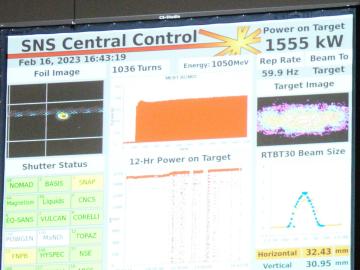
Filter News
Area of Research
- (-) Fusion and Fission (19)
- (-) Neutron Science (32)
- (-) Supercomputing (73)
- Advanced Manufacturing (1)
- Biological Systems (1)
- Biology and Environment (56)
- Building Technologies (1)
- Clean Energy (63)
- Computational Engineering (1)
- Computer Science (2)
- Electricity and Smart Grid (1)
- Energy Sciences (1)
- Fuel Cycle Science and Technology (1)
- Fusion Energy (3)
- Isotope Development and Production (1)
- Isotopes (15)
- Materials (76)
- Materials Characterization (2)
- Materials Under Extremes (1)
- National Security (26)
- Nuclear Science and Technology (2)
News Topics
- 3-D Printing/Advanced Manufacturing (1)
- Advanced Reactors (1)
- Artificial Intelligence (15)
- Big Data (4)
- Bioenergy (4)
- Biology (4)
- Biomedical (4)
- Biotechnology (2)
- Buildings (1)
- Chemical Sciences (5)
- Clean Water (1)
- Climate Change (9)
- Composites (1)
- Computer Science (11)
- Coronavirus (1)
- Critical Materials (2)
- Cybersecurity (1)
- Decarbonization (4)
- Energy Storage (3)
- Environment (6)
- Exascale Computing (13)
- Fossil Energy (1)
- Frontier (16)
- Fusion (5)
- Grid (1)
- High-Performance Computing (20)
- Isotopes (1)
- Machine Learning (5)
- Materials (11)
- Materials Science (4)
- Microscopy (1)
- Nanotechnology (4)
- National Security (3)
- Net Zero (2)
- Neutron Science (25)
- Nuclear Energy (10)
- Partnerships (2)
- Physics (2)
- Quantum Computing (7)
- Quantum Science (4)
- Security (1)
- Simulation (12)
- Software (1)
- Space Exploration (1)
- Summit (6)
- Sustainable Energy (2)
- Transportation (2)
Media Contacts

Mickey Wade has been named associate laboratory director for the Fusion and Fission Energy and Science Directorate at the Department of Energy’s Oak Ridge National Laboratory, effective April 1.

A team of scientists led by the Department of Energy’s Oak Ridge National Laboratory designed a molecule that disrupts the infection mechanism of the SARS-CoV-2 coronavirus and could be used to develop new treatments for COVID-19 and other viral diseases.

A chemist from Oak Ridge National Laboratory attracted national attention when her advocacy for science education made People magazine’s annual “Women Changing the World” issue.

Nine engineers from ORNL visited 10 elementary and middle school classrooms in three school districts during National Engineers Week, Feb. 21 to 24, 2023, describing and demonstrating the excitement of the engineering profession to more than 300 Tennessee students.

Scientists have long sought to better understand the “local structure” of materials, meaning the arrangement and activities of the neighboring particles around each atom. In crystals, which are used in electronics and many other applications, most of the atoms form highly ordered lattice patterns that repeat. But not all atoms conform to the pattern.

ORNL has entered a strategic research partnership with the United Kingdom Atomic Energy Authority, or UKAEA, to investigate how different types of materials behave under the influence of high-energy neutron sources. The $4 million project is part of UKAEA's roadmap program, which aims to produce electricity from fusion.

A scientific instrument at ORNL could help create a noninvasive cancer treatment derived from a common tropical plant.

Environmental scientists at ORNL have recently expanded collaborations with minority-serving institutions and historically Black colleges and universities across the nation to broaden the experiences and skills of student scientists while bringing fresh insights to the national lab’s missions.

Warming a crystal of the mineral fresnoite, ORNL scientists discovered that excitations called phasons carried heat three times farther and faster than phonons, the excitations that usually carry heat through a material.

ORNL's Spallation Neutron Source set a world record when its linear accelerator reached an operating power of 1.55 megawatts, which improves on the facility’s original design capability.


